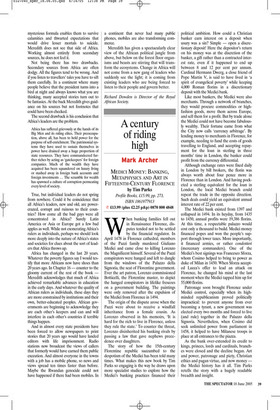A century of riding high
Mark Archer
MEDICI MONEY: BANKING, METAPHYSICS AND ART IN FIFTEENTH-CENTURY FLORENCE by Tim Parks Profile Books, £15.99, pp. 273, ISBN 1861977913 ✆ £13.99 (plus £2.25 p&p) 0870 800 4848 When banking families fell out in Renaissance Florence, disputes tended not to be settled by the financial regulator. In April 1478 in Florence cathedral, members of the Pazzi family murdered Giuliano Medici and came close to killing Lorenzo the Magnificent himself. Several of the Pazzi conspirators were hanged and left to dangle from the windows of the Palazzo della Signoria, the seat of Florentine government. Ever the art patron, Lorenzo commissioned Botticelli, the Florentine master, to depict the hanged conspirators in lifelike frescoes on a government building. The paintings were only removed after the expulsion of the Medici from Florence in 1494.
The origin of the dispute arose when the Pazzi were about to receive a windfall inheritance from a female cousin. As Lorenzo observed in his memoirs, ‘It is hard for the rich to live in Florence, unless they rule the state.’ To counter the threat, Lorenzo disinherited his banking rivals by passing a law that gave nephews precedence over daughters.
The story of how the 15th-century Florentine republic succumbed to the despotism of the Medici has been told many times. What makes this new book by Tim Parks so engaging is the way he draws upon more specialist studies to explore how the Medici’s banking practices financed their political ambition. How could a Christian banker earn interest on a deposit when usury was a sin? Simple — open a discretionary deposit! Here the depositor’s return on his money was at the discretion of the banker, a gift rather than a contracted interest rate, even if it happened to end up between 8 and 12 per cent per annum. Cardinal Hermann Dwerg, a close friend of Pope Martin V, is said to have lived in ‘a spirit of evangelical poverty’ while keeping 4,000 Roman florins in a discretionary deposit with the Medici bank.
Like most bankers, the Medici were also merchants. Through a network of branches, they would procure commodities or highfashion goods, move them across Europe, and sell them for a profit. But by trade alone the Medici could not have become fabulously wealthy. Their fortune came from what the City now calls ‘currency arbitrage’. By lending money to merchants in Florence, for example, needing to fund the costs of goods travelling to England, and accepting repayment for the loan in sterling in three months’ time in London, the banker could profit from the currency differential.
Although exchange rates were fixed daily in London by bill brokers, the florin was always worth about four pence more in Florence than in London. And having pocketed a sterling equivalent for the loan in London, the local Medici branch could repeat the trade in the opposite direction. Such deals could yield an equivalent annual interest rate of 22 per cent.
The Medici bank existed from 1397 and collapsed in 1494. In its heyday, from 1435 to 1450, annual profits were 19,386 florins. At this time, a respectable palazzo would cost only a thousand to build. Medici money financed popes and won the people’s support through lower taxes. More importantly, it financed armies, or rather condottieri (mercenary commanders). One of the Medici’s best signings was Francesco Sforza, whom Cosimo helped to bring to power as duke of Milan in 1450. When Sforza accepted Lucca’s offer to lead an attack on Florence, he changed his mind at the last moment when the Medici tapped him up for 55,000 florins.
Patronage soon brought Florence under Medici control, especially when its highminded republicanism proved politically impractical: to prevent anyone from ever becoming a tyrant, a new government was elected every two months and forced to live (and rule) together in the Palazzo della Signoria. Nevertheless, when Cosimo did seek unlimited power from parliament in 1458, it helped to have Milanese troops in place at all entrances to the piazza.
As the bank over-extended its credit to kings, princes, lords and cardinals, branches were closed and the decline began. Art and power, patronage and piety, Christian ethics and pagan virtue, and now money the Medici history has it all. Tim Parks retells the story with a hugely readable breadth and insight.
















































 Previous page
Previous page